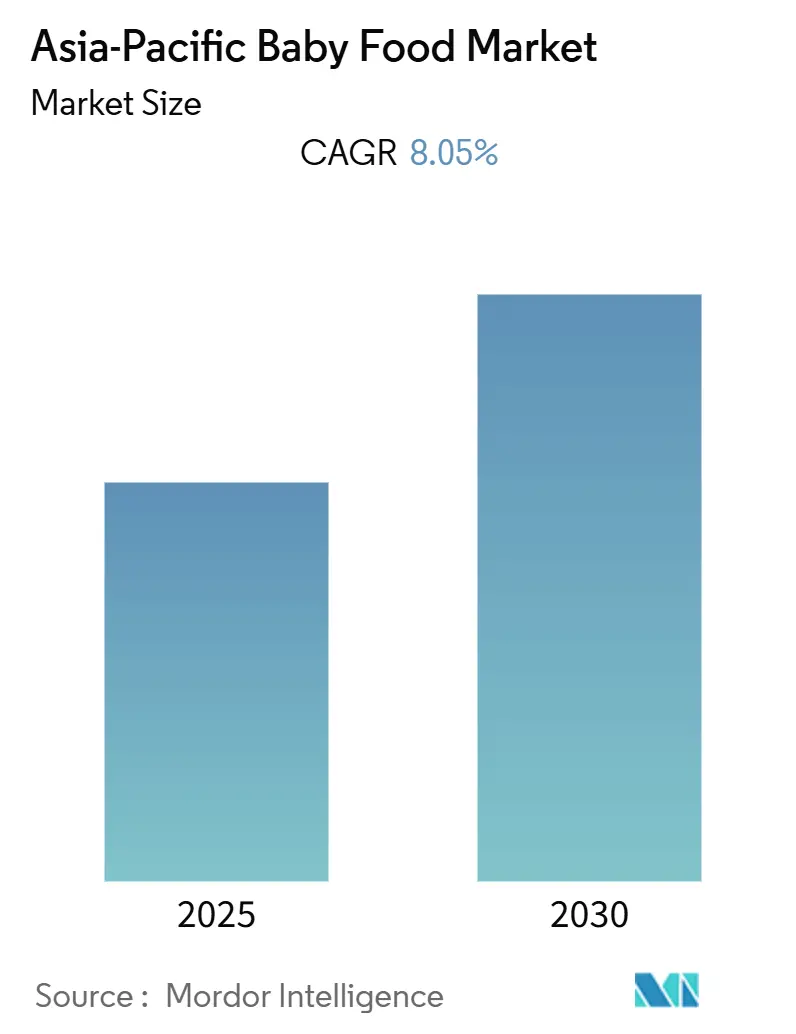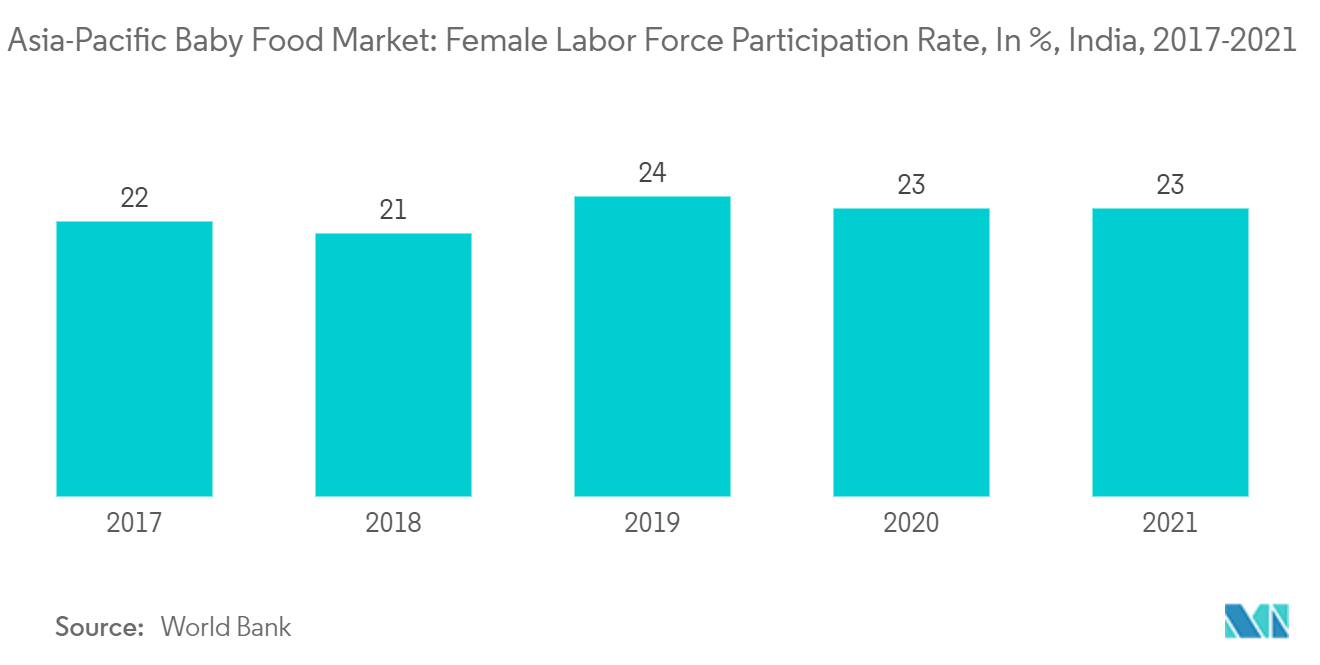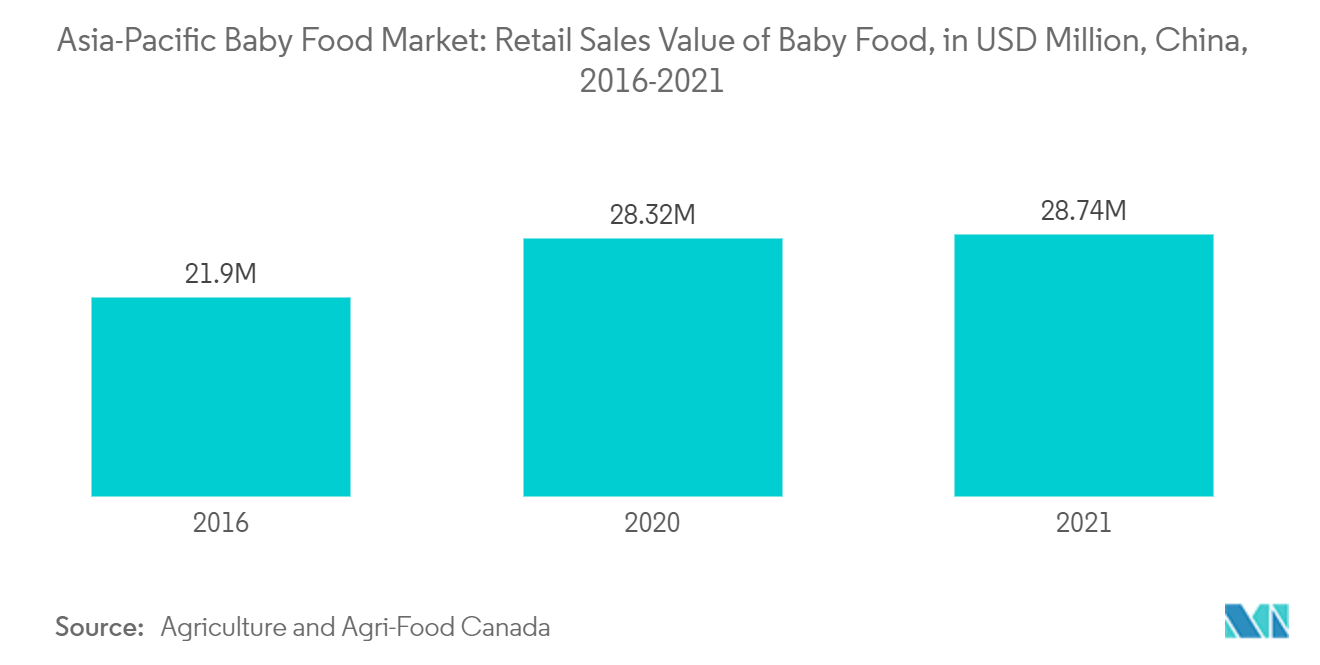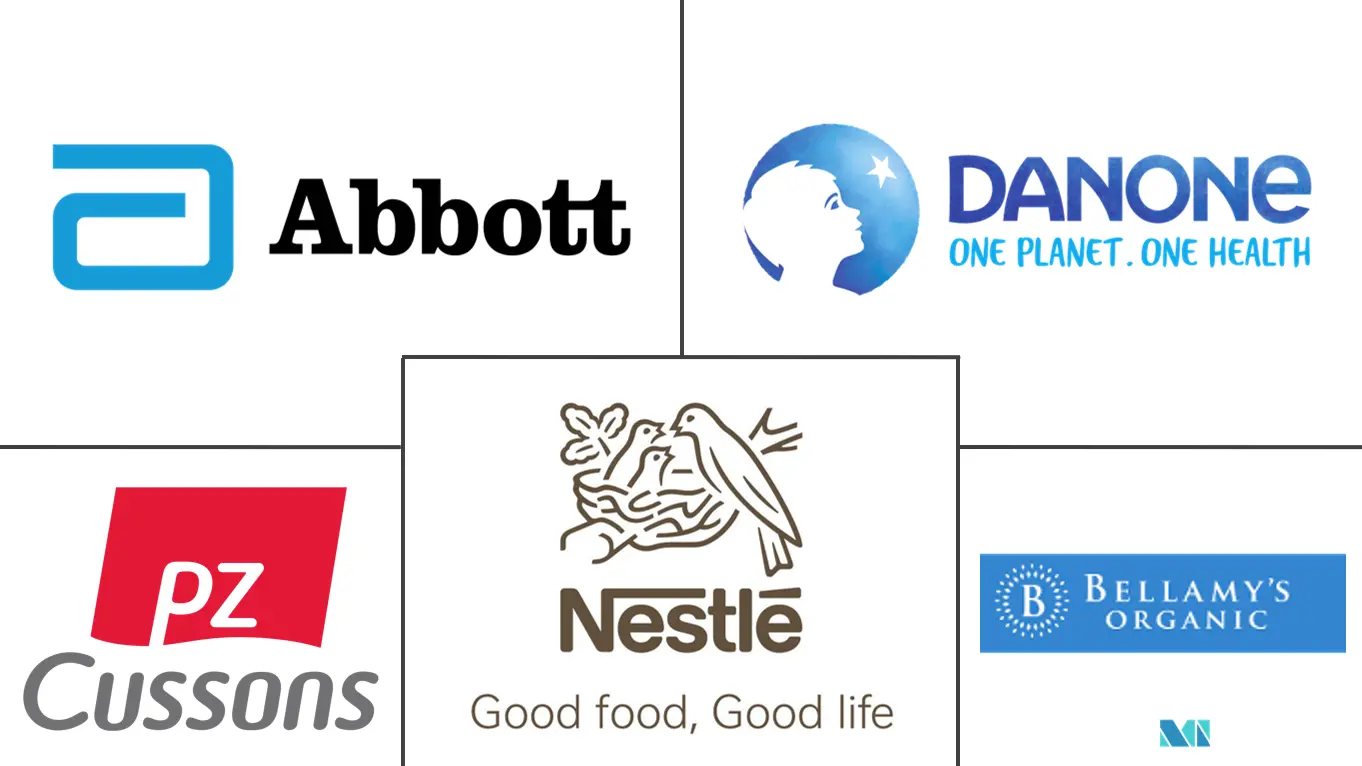
Asia-Pacific Baby Food Market Analysis by Mordor Intelligence
The Asia-Pacific Baby Food Market is expected to register a CAGR of 8.05% during the forecast period.
The Asia-Pacific baby food industry is driven by the rising number of malnutrition instances, the increasing number of working women, and concerns for the overall growth of babies. Parents have boosted their spending due to rising disposable income. The rising working population, particularly among women, and urbanization have fostered convenience-oriented lifestyles, boosting the demand for organic baby food and, consequently, baby food sales. The Asia-Pacific baby food market witnessed a shift from conventional to organic products, owing to factors such as a rise in parental concerns over baby nutrition, increased awareness concerning the benefits associated with organic products, and eco-friendly farming techniques. These factors are expected to boost the demand for organic baby food products. Hence, the demand for baby food with no added preservatives is surging at a robust pace globally. To capitalize on the growing demand, key players in the market are focusing on introducing lactose-free, gluten-free products with zero added preservatives.
Government initiatives may further drive the growth of the region's baby food market. For instance, from 2021 through 2025, the National Health Commission of China (NHC) released a new action plan for improving child health. By 2025, the death rates of newborn babies, infants, and children under the age of five will be maintained below 3.1, 5.2, and 6.6 per thousand, respectively, according to the action plan. In addition, the rate of growth retardation among children under the age of five will be kept to less than 5%. The strategy focuses on seven major areas, including newborn protection, congenital disability prevention, healthcare, and early childhood development services.
Asia-Pacific Baby Food Market Trends and Insights
Increasing Awareness Among People and Working Women
The increasing awareness about providing additional benefits to the baby is driving the market. Baby food offers benefits such as vitamins and minerals like iron and essential fatty acids. Baby food products also contain probiotics found in breastfed babies' digestive tracts. Asia-Pacific is also home to the world's two major emerging economies, China and India, with considerable disposable income. The Asia-Pacific baby food market is driven by the rising number of women working in Asian countries. Since many working mothers return to their jobs shortly after giving birth, prepared or ready-to-eat baby foods and formulas are an appealing alternative for working mothers to provide their children with nutritious food.
The demand for organic baby food is expanding due to an increase in working women and a quick shift toward convenience foods, propelling the organic baby food market. There is a paradigm shift in the organization of modern households, with most adults needing more time for home administration, particularly food preparation and cooking. As a result, there is a rise in the demand for ready-to-eat or packaged foods. The baby food market is trending toward vegan-based foods. It is considered safe and nutritious for babies to eat vegan-based baby food. Baby food manufacturers are launching vegan-based products to cater to the growing vegan market. For instance, in July 2022, Nestle introduced China's first carbon-neutral product, a stage three formula for toddlers derived from farms in Switzerland that do not use herbicides or growth hormones. The tin lid and scoop of the product, known as Organic NAN 3, are also said to be manufactured from plant-based materials.

Increasing Population in the Region is Driving the Asia-Pacific Baby Food Market
China is a significant contributor and dominates the Asia-Pacific baby food market owing to its vast population and long-standing practice of eating milk formula. The Chinese baby food industry is being driven by the rising number of malnutrition instances and health concerns for babies' overall growth. The baby food market may be further boosted by the country's decreasing child mortality rate and increasing urbanization rate. According to the United Nations' World Population Prospects, China's infant mortality rate is 8.996 deaths per 1000 live births in 2021, down 3.22% from 2020. According to the World Bank, China's urban population in 2020 was 861,289,359, up 2.18% from 2019 which is increasing the demand for baby food products in the country.
Parents have boosted their spending as the economy has improved. They are willing to spend money on high-quality, expensive food for children's health. This trend has also propelled the demand for organic food as it is produced from pesticide-free fruits and vegetables and meat from animals without antibiotics or growth hormones. It is free of artificial flavors, preservatives, and colors. Due to these reasons, major players are investing in this market. For instance, in May 2021, Nestlé opened a factory in China to produce pouched baby food as part of a round of investment in the country's east. The world's largest food company has begun producing organic puree items for sale in China under its international baby-food brand Gerber at a factory in Laixi, Shandong province.

Competitive Landscape
The Asia-Pacific baby food market is highly competitive in nature, with the presence of many local and international players. Nestle SA, Abbott Laboratories, Bellamy's Organic, Danone SA, and PZ Cussons PLC are major players in the Asia-Pacific baby food market. Companies focus on expanding facilities, mergers, acquisitions, and product launches to gain market share. For instance, in May 2021, Nutrilon Yunhui Stage 3 was Danone's first formula milk produced in China at Danone's Qingdao production site and launched in China at the beginning of April. The new formula contains a high level of vitamin D and four major vitamins in the vitamin B group. The companies are investing in research and development to produce high-quality ingredients and attract more consumers.
Asia-Pacific Baby Food Industry Leaders
Nestle S.A
Abbott Laboratories
Danone S.A.
PZ Cussons plc
Bellamy's Organic
- *Disclaimer: Major Players sorted in no particular order

Recent Industry Developments
- November 2022: Nestle Cerelac Homestyle for babies introduced a new variant, meat and vegetable (Daging Sayur), in Indonesia to introduce babies to the goodness of vegetables and meat. Cerelac Homestyle is rich in iron and comes with 10 vitamins and five minerals to combat anemia, which affects babies aged 1-6.
- July 2022: Rafferty's Garden, a brand of PZ Cussons in Australia, teamed up with Vegemite to release a new snack available on supermarket shelves across the country. Rafferty's Garden introduced Vegemite Cheesy Bread Sticks, a snack for kids aged 12 months and above. This delectable snack, made with Vegemite, is a category-first flavor profile containing vitamin B and prebiotics, intended to help introduce the taste of Australia to little buds.
- August 2021: Australian pharma and nutraceutical company Max Biocare expanded its baby food brand Little Étoile with a new infant and toddler formula range. Little Etoile Nutrition's infant and toddler formulas contain ingredients such as lactoferrin and Wellmune beta-glucan that were clinically tested for safety and efficacy. These ingredients were used to promote immunity and reduce the frequency of common cold and upper respiratory tract infections. The formulas are made from 100% Australian grass-fed cow's milk, without added sugar, and are compliant with Codex regulations.
Asia-Pacific Baby Food Market Report Scope
Baby food is any soft, easily digestible meal created particularly for human babies aged 4-6 to two years old.
The Asia-Pacific baby food market is segmented by type (milk formula, dried baby food, prepared baby food, and other types), distribution channel (hypermarket/supermarket, drugstores/pharmacies stores, convenience stores, online retail stores, and other distribution channels), and geography (India, China, Japan, Australia, and Rest of Asia-Pacific). The report offers market size and values in (USD million) during the forecast period for the above segments.
| Milk Formula |
| Dried Baby Food |
| Prepared Baby Food |
| Other Types |
| Hypermarkets/Supermarkets |
| Drugstores/Pharmacies Stores |
| Convenience Stores |
| Online Retail Stores |
| Other Distribution Channels |
| India |
| China |
| Japan |
| Australia |
| Rest of Asia-Pacific |
| Type | Milk Formula |
| Dried Baby Food | |
| Prepared Baby Food | |
| Other Types | |
| Distribution Channel | Hypermarkets/Supermarkets |
| Drugstores/Pharmacies Stores | |
| Convenience Stores | |
| Online Retail Stores | |
| Other Distribution Channels | |
| Geography | India |
| China | |
| Japan | |
| Australia | |
| Rest of Asia-Pacific |
Key Questions Answered in the Report
What is the current Asia-Pacific Baby Food Market size?
The Asia-Pacific Baby Food Market is projected to register a CAGR of 8.05% during the forecast period (2025-2030)
Who are the key players in Asia-Pacific Baby Food Market?
Nestle S.A, Abbott Laboratories, Danone S.A., PZ Cussons plc and Bellamy's Organic are the major companies operating in the Asia-Pacific Baby Food Market.
What years does this Asia-Pacific Baby Food Market cover?
The report covers the Asia-Pacific Baby Food Market historical market size for years: 2019, 2020, 2021, 2022, 2023 and 2024. The report also forecasts the Asia-Pacific Baby Food Market size for years: 2025, 2026, 2027, 2028, 2029 and 2030.
Page last updated on:
Asia-Pacific Baby Food Market Report
Statistics for the 2025 Asia-Pacific Baby Food market share, size and revenue growth rate, created by Mordor Intelligence™ Industry Reports. Asia-Pacific Baby Food analysis includes a market forecast outlook for 2025 to 2030 and historical overview. Get a sample of this industry analysis as a free report PDF download.



